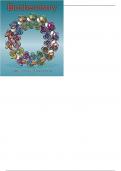,Chapter 1—The Facts of Life: Chemistry Is the Logic of Biological Phenomena
MULTIPLE CHOICE
1. All are distinctive properties of living systems EXCEPT:
a. Living organisms are relatively simple.
b. Biological structures play a role in the organism's existence.
c. The living state is characterized by the flow of energy through the organism.
d. Living organisms are highly organized.
e. Living organisms are actively engaged in energy transformation.
ANS: A PTS: 1
2. Even though the building blocks have fairly simple structures, macromolecules are exquisitely
organized in their intricate three-dimensional architecture known as:
a. configuration.
b. conformation.
c. sequence.
d. Lewis structure.
e. structural maturation.
ANS: B PTS: 1
3. All of the following activities require the presence of ATP or NADPH EXCEPT:
a. osmoregulation.
b. biosynthesis.
c. movement of muscles.
d. light emission.
e. none, they are all energy-requiring activities.
ANS: E PTS: 1
4. Which are the four most common elements in the human body?
a. hydrogen, calcium, oxygen and sodium
b. hydrogen, oxygen, iron and carbon
c. hydrogen, oxygen, carbon and nitrogen
d. oxygen, carbon, iron and nitrogen
e. oxygen, silicon, calcium and nitrogen
ANS: C PTS: 1
5. What makes carbon such an abundant element in biomolecules?
a. It can form up to five bonds by sharing its electrons.
b. It forms only single bonds.
c. It provides low bond energy.
d. It forms stable covalent bonds by electron pair sharing.
e. It does not usually bond to other carbons, allowing a more diverse combination of
elements.
ANS: D PTS: 1
Garrett/Grisham 5e Test Bank 1
, 6. The major precursors for the formation of biomolecules include all EXCEPT:
a. nitrate and dinitrogen.
b. water.
c. carbon dioxide.
d. ammonium ion.
e. none, all are major precursors.
ANS: E PTS: 1
7. From the major precursors, the complex biomolecules are made in which sequence?
a. metabolites, building blocks, macromolecules, supramolecular complexes
b. macromolecules, building blocks, metabolites, supramolecular complexes
c. building blocks, macromolecules, supramolecular complexes, metabolites
d. metabolites, macromolecules, building blocks, supramolecular complexes
e. metabolites, building blocks, supramolecular complexes, macromolecules
ANS: A PTS: 1
8. The structural integrity of supramolecular complexes (assemblies) of multiple components are
bonded to each other by all of the following forces EXCEPT:
a. covalent bonds
b. van der Waals forces
c. hydrogen bonds
d. hydrophobic interactions
e. ionic interactions
ANS: A PTS: 1
9. Organelles have what three attributes?
a. Only in prokaryotic cells, membrane bound, have a dedicated set of tasks.
b. Only in eukaryotic cells, membrane bound, have a dedicated set of tasks.
c. Only in eukaryotic cells, seldom membrane bound, have a dedicated set of tasks.
d. Only in prokaryotic cells, membrane bound, multi-functional.
e. In both prokaryotic cells and eukaryotic cells, membrane bound, have a dedicated set of
tasks.
ANS: B PTS: 1
10. Membrane structures are maintained primarily by:
a. hydrophobic interactions.
b. covalent bonds.
c. hydrogen bonds.
d. non-spontaneous assembly.
e. ionic interactions.
ANS: A PTS: 1
11. All of the following are properties of membranes EXCEPT:
a. supramolecular assemblies.
b. define boundaries of cellular components.
c. spontaneous assemblies resulting from hydrophobic interactions.
d. identical protein and lipid composition in the major organelles.
e. none, all are true.
ANS: D PTS: 1
Garrett/Grisham 5e Test Bank 2
, 12. Which of the following properly ranks the non-covalent interactions in order of increasing strength?
a. ionic, hydrogen bond, van der Waals
b. van der Waals, hydrogen bond, ionic
c. van der Waals, ionic, hydrogen bond
d. hydrogen bond, van der Waals, ionic
e. cannot be determined since ionic interactions and hydrogen bonds often vary in strength
ANS: E PTS: 1
13. Weak forces that create constantly forming and breaking interactions at physiological temperatures,
but cumulatively impart stability to biological structures generated by their collective activity include
all EXCEPT:
a. hydrogen bonds
b. van der Waals forces
c. covalent bonds
d. ionic interactions
e. hydrophobic interactions
ANS: C PTS: 1
14. Which of the following is a true statement about non-covalent bonds?
a. They are all the result of electron sharing.
b. Hydrogen bonds, ionic bond and hydrophobic interactions all carry a degree of specificity
while van der Waals interactions are induced.
c. All noncovalent bonds are formed between oppositely charged polar functions.
d. Van der Waals interactions are not affected by structural complementarity, while hydrogen
bonds, ionic bonds and hydrophobic interaction are affected by structural
complementarity.
e. Hydrogen, van der Waals, and hydrophobic interactions do not form linear bonds.
ANS: B PTS: 1
15. Which of the statements about the nature of the hydrogen bond is true?
a. The donor is a hydrogen atom bonded to a carbon.
b. The more linear the bond, the stronger the interaction.
c. The acceptor must be similar in electronegativity to hydrogen.
d. It is a type of covalent bond.
e. A hydrogen bond is weaker than van der Waals forces.
ANS: B PTS: 1
16. Electrostatic forces
a. include ionic interactions between negatively charged carboxyl groups and positively
charged amino groups.
b. average about 2 kJ/mol in aqueous solutions.
c. typically are directional like hydrogen bonds.
d. require a precise fit like van der Waals interactions.
e. include ionic, induced dipole and permanent dipole interactions.
ANS: A PTS: 1
Garrett/Grisham 5e Test Bank 3




